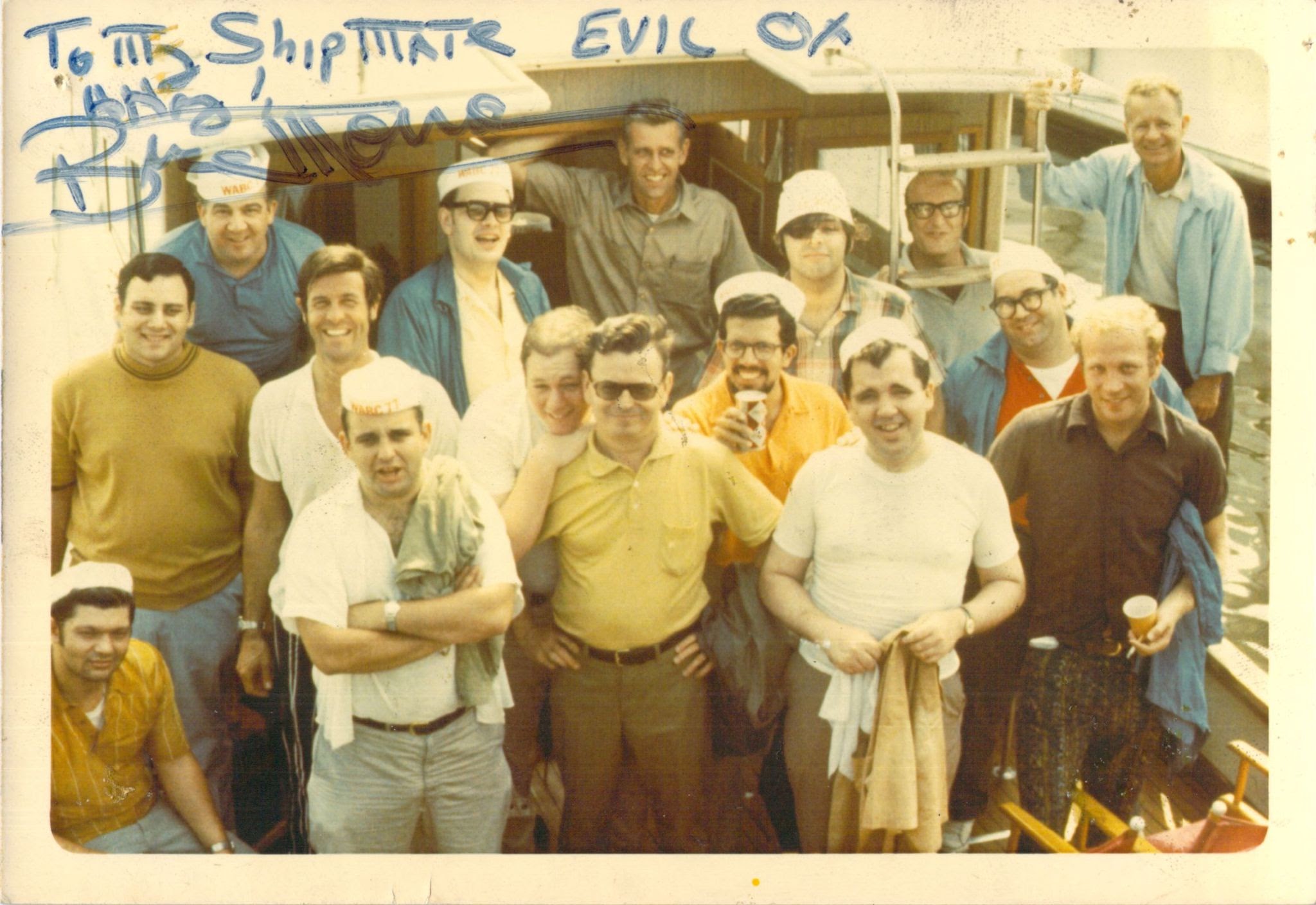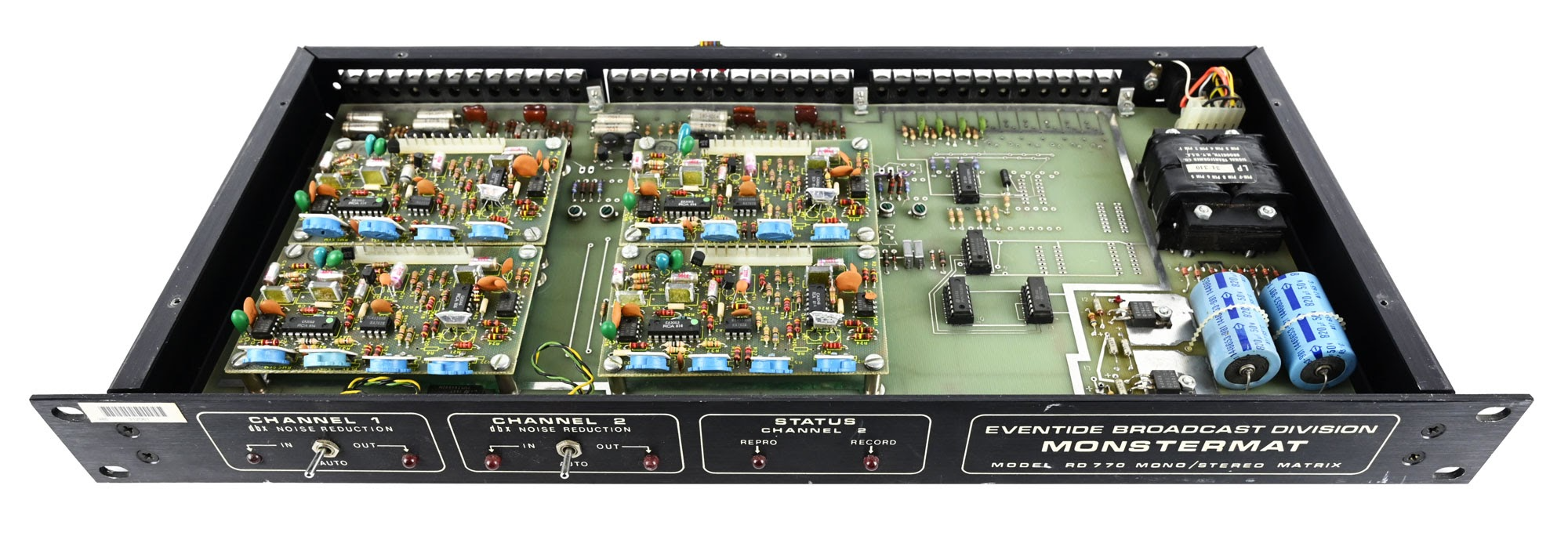
While the mainstay of Eventide has been our 50-year continuous history of making products for music recording and performing, we’ve also made products specifically for broadcasters for almost that long. In fact, Richard Factor got his ‘start’ in radio, designing products for broadcasters years before founding Eventide. So strap in for a deep dive into our broadcast history as Richard recalls his personal history with and within broadcast.
The Broadcast Products that Were and Weren’t
I would guess that a significant percentage of young readers don’t relate to the actual meaning of the term “broadcast.” It is possible that they have grown up listening to what I call internet ‘radio’ ‘stations,’ along with YouTube and other streaming services. Let me assure you, 50 years ago, broadcast meant BROADcast. Your radio and teevee stations were actual stations, no air- or scare-quotes needed. They occupied specific physical locations on the planet and used electromagnetic radiation to send signals in some or all directions. Although such stations still exist, many fewer audience members receive their programs using antennas, preferring instead to get “content,” as we now call it, over the internet.
There Are Implications…

For example, no more CONELRAD! Now, in case of war, the Soviet Bombers* will be able to home in on the transmissions of the remaining stations. CONELRAD was supplanted by EBS in 1963, and radio stations had the sacred duty of monitoring other radio stations to know when the bombers were approaching and to relay an alert. The actual alert never came, but test alerts did, and they had to be logged. So <fiction> radio stations would have to hire a person whose only job was to listen to other stations for these alerts and log them </fiction> or, in the case of actual soviet bombers, open an envelope and confirm that the secret word was part of the alert message and then dive under the radiation-proof broadcast console. Except…Those pesky human beings were as expensive and unpredictable then as they are now. Since they were busy doing other things, alerts often didn’t get logged. Which is a roundabout way to lead into my first broadcast “product,” which both was and wasn’t. I built one and one only, on the station’s dime, while employed as a “broadcast engineer.”
I don’t remember if I ever received payment for the article itself, which now seems risible for its detailed circuit description. But was I ever proud to have my name in a broadcast engineering magazine (prosaically called “Broadcast Engineering”) associated forever with my employer, WABC! At the time, it was the most listened-to station on earth. WooHoo! I don’t know if I ever mentioned this, but if Eventide turned 50 about the same time I turned 75, it must mean that I had a “life” even before Eventide. That life, such as it was, pretty much was obsessed with radio, both ham and broadcast.
Another implication: Unlike the ‘radio’ ‘stations’ of today, the stations of yesteryear were regulated by the FCC, the Federal Communications Commission, since they used the “public airwaves” instead of private wires and fibers. The FCC, then as now, was run by “commissioners” who were political appointees charged with making sure that broadcasters operated in PICON (which you’ll have to look up since I’ve run out of asterisks for this blog). They did this in several ways. One was mentioned above: preventing destruction of the United States by Soviet bombers. Equally—or perhaps more—important was the protection of listeners from profanity. I’ll get to that and more in Flashback 9.2 but for now…
A Bit of Supplemental History
Eventide remains a work in progress. I found this ten-year-old item on our website, and it explains how we came up with our initial products. It doesn’t say how we didn’t come up with products we didn’t make, and I’d like to mention a couple here, with regrets.
In 1971, there was almost no digital signal processing or computer memory, but there were plenty of disk jockeys—then people who played records on the radio. They all had voices, they all used microphones, and they all sounded different. (At WABC they all sounded really, really good, too.) But did they sound their best? Maybe not! I had the notion to build a voice processor that would equalize frequency response and adjust compression and maybe other characteristics for each individual DJ. How would it work? Each DJ, after some experimentation and with the discernment of the program director, would be given a plastic punch card which would be configured to switch in or out specific components in the processor’s circuit. When the DJ began his air shift, he would insert the card in our notional product. A good idea then, possibly a good idea now. What went wrong? Card readers were unreliable and, worse, expensive. We didn’t have the bandwidth to do this along with everything else. In fact, in the very beginning, we didn’t have much we, either. We have a much bigger we in our fiftieth year, but we still can’t do everything else. Sigh.
Another nonexistent product: The digital cart machine

There was a long transition period—decades—between tape and digital. The cart machine was expensive, large, mechanical, unreliable, and inconvenient. But at least it was very wasteful in terms of resources such as people and plastic. Wouldn’t it be great to replace these unwieldy mechanisms with a little box that would play ads, jingles, and maybe even music? All you need is memory and an interface. Once again, the lack of resources prevented its development. (Kudos to 360 Systems who stole the idea, possibly even before we thought of it, and introduced the product we wanted to make before we didn’t.)
An Aside—Robert (Bob) Deitsch, WABC-AM and FM
Previous Eventide Flashbacks have commented on how some of our products got their names. The famous H910 Harmonizer® special effects unit’s number, for example, isn’t what you think you knew it was, even if you were right! Back when real radio stations had call letters (e.g., WABC) assigned by the FCC, they also had broadcast frequencies, unlike the internet with its URLs. WABC-AM was on 770kHz, and WABC-FM (later WPLJ) was on 95.5MHz. Deitsch was a colleague of mine at WABC. He earned a degree in philosophy at Columbia University and so of course was promoted to Chief Engineer at the station.
Here’s a photo of the WABC engineering team assembled with Cousin Brucie on the WABC Radio Cruiser. Bob is 2nd from left, back row. I’m the eye-patch-wearing pirate!

Bob was an inspiration, and I mean that literally, to Eventide. The inspiration was that there were products in need of being created. Eventide was an established manufacturer of electronic equipment in 1976. Bob and I defined a couple of products that the station could surely use and which we could manufacture.
The RD770 Monstermat

If you remember how complimentary I was above to the execrable cart machine, you’ll understand why the Monstermat was a useful product. I only wish we had made them earlier and for more years before the cart became obsolete. May I ennutshellize the issue? Professional tape recorders, some may remember, are large mechanical devices that, before their relegation to special applications, were precision devices that did a very good job of recording and playing audio. A cart(ridge) machine was a tape recorder whose precision was subject to insult every few minutes. The cartridges themselves, plastic and inexpensive, lacked any precision to begin with. Broadcasters would record their ads, promos, and music on one machine, yank out the cartridge, and jam it into another machine to be played. The machines, even if identical to begin with, suffered tiny deformations with each insertion, and keeping the tape heads “aligned” was a challenge. This mattered especially in FM broadcasting—and universally in stereo in later years—because any misalignment of the tape head would wreak havoc on the monaural signal to which most people nonetheless listened.
The Monstermat, which stands for “MONoSTEReoMATrix, solved this problem as simply as its name implies! Instead of recording the two halves of a stereo signal on two easily misaligned tape tracks, it would record the sum of the two signals on one tape track and the difference between them on the other. This would render misalignment of the tape heads less relevant since the mono signal (L+R) would always be recorded together, and a listener to a mono signal wouldn’t hear bad frequency response or even flanging (not that we have anything against that). The trade-off is that a stereo listener would experience reduced channel separation, a far lesser sin and a generally inaudible one unless using headphones with a quality receiver.
The Eventide RD770 Monstermat. Note the 4 DBX Noise Reduction Cards:

By adding DBX Noise Reduction, the signal-to-noise ratio of the cart machine, albeit generally adequate, was greatly improved. We bought DBX noise reduction circuit cards from DBX themself, and so the design of the product was promptly realized. A certain radio station, whose frequency and chief engineer’s initials somehow made their way into the product’s model number, got its needed improvement, to the technical and financial joy of many. (I will take credit for the product’s name. If it had been introduced in recent days of hypertrophied social media, I suspect it would have sported quite the entertaining logo as well.)
*CONELRAD would have prevented that, but Soviet Bombers would now use different and more precise navigation systems to find their targets, if there were still Soviet bombers.
RD770 Monstermat Deep Dive
Visit the RD770 legacy page and read more about Broadcast on Richard’s blog.
Check out our previous flashbacks!
- Flashback #1: The Instant Phaser
- Flashback #2.1: The DDL 1745 Delay
- Flashback #2.2: The DDL 1745A Delay
- Flashback #2.3: The DDL 1745M Delay
- Flashback #3: The Omnipressor®
- Flashback #4.1: The H910 Harmonizer®
- Flashback #4.2: H910 Harmonizer® — The Product
- Flashback #4.3: H910 Harmonizer® — “Minds Blown”
- Flashback #5: FL 201 Instant Flanger
- Flashback #6: HM80 — The Baby Harmonizer®
- Flashback #7.1: The H949 Harmonizer®
- Flashback #7.2: H949 Harmonizer® — The New One
- Flashback #7.3: H949 Harmonizer® — Bending, Stretching, and Twisting Time
- Flashback #8: H969 Harmonizer®
- Flashback #9.1: Broadcast
- Flashback #9.2: Dump & Go – The Profanity Delay
- Flashback #10: Thinking Outside the Black Box


